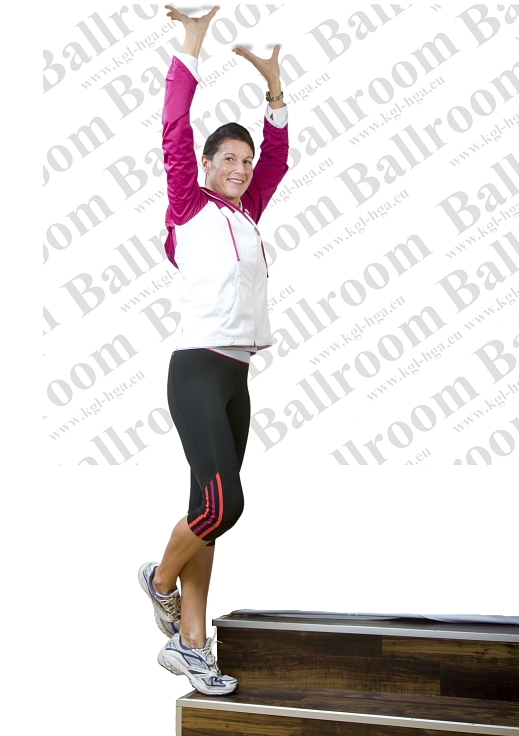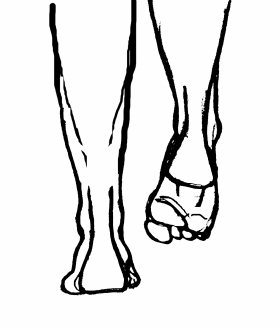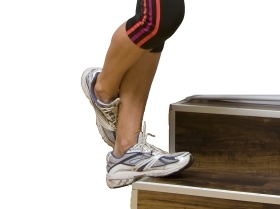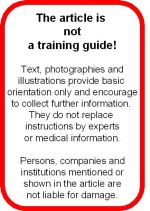1
Muscles for the Ballroom – Fitness Training for Dancesport:
Footwork.
Text: Kerstin Lange Photography and illustrations: Helmut Römhild

Liftups on a single foot: The heel can move freely which is necessary to stretch the calf muscles.
|
The feet are the dancer’s main tool. They maintain ground contact and control speed and direction of
the movements. They control stability. |
The explosive and fast footwork of Quickstep, the flow of raising and lowering in Slow Waltz and Slowfox is only possible with correct
and accurate use of the feet – not only to dance on a superior level but also to avoid injuries.
Unfortunately the involved muscles are very different in strength and performance – a natural imbalance which very often prevents efficient and
safe footwork.
The involved muscles are very different in strength and performance.
It is easy to observe the muscular imbalance. Just raise the lower leg and relax. This is what happens in
most cases:
| • | The front of the dangling foot points inward and downward. |
| • | The foot is tilted inward, the ankle bent outward. |

In dancesport under the impact of training and competition this tendency leads to several issues:
| • | imprecise footwork, especially when stepping backwards. It causes instability. |
| • | The inward tilt can lead to ankle injuries: the dancer can easily sprain the foot, especially the ladies on high heels. |
| • | Pain from a strained achilles tendon, even a rupture of the achilles tendon. |
Workout in Dancesport.
The seemingly effortless way of ballroom dancers to move to the music is a result of considerable fitness. Already the basics of correct posture require strength and an optimised coordination of ligaments,
tendons and muscles.
Dancing alone is not enough to improve strength and mobility.
On the contrary: dancing means to make the system of muscles, tendons, and ligaments work for hours and hours, relentlessly
exploiting the individual possibilities and pushing beyond.
You have to work out to compensate the demands of your sport and to match your rising aspirations as a dancer.
In a short series of articles Ballroom will explain the anatomy involved and discuss exercises to improve
mobility, build up strength, and avoid injuries.
Fitness Trainer Ute Römhild, Trainer Assistant Marc Moder and model Martina contribute expert knowledge and show how to work out effectively.
Incorrectly performed exercises can damage your health!
Consult a fitness instructor before starting to exercise and exercise under supervision of a fitness instructor.
Expert advice is provided by Ute Römhild and Marc Moder.
Ute Römhild
Fitnesstrainer
TSV Glinde von 1930 e.V.
www.tsv-glinde.de
Marc Moder
Trainer Assistant
TSV Glinde von 1930 e.V.
www.tsv-glinde.de
The the pictures were taken at the fitness studio of sportsclub TSV Glinde. We are grateful for the generous support.
TSV Glinde von 1930 e.V.
www.tsv-glinde.de
The feet are an arrangement of small bones held in place by a complex web of tendons.
They have 2 major weak spots:
| • | The achilles tendon which connects calf and heel. It can tear apart under the strain of powerful movements. |
| • | The fragile bones which can break due to wear. |
and it can also catapult the body into the air and absorb the impact when landing.
Inside the foot are the muscles which control the shape.
For a rough orientation remember:
| • | The muscles at the front of the lower leg pull upwards: the front of the foot, the foot’s outer side, the toes. |
| • | The muscles at the back pull the front of the foot downwards and the foot’s inside upwards. |
The 2 calf muscles in each leg are among the strongest in the human body.
They lower the foot by pulling at the achilles tendon and make the foot lift heavy weights.
and they become weaker over time while the strong calf muscles at the back become shorter
producing a difference in strength and performance.
The weakness of the front muscles increases the inward tilt of the foot:
While the strong calf muscles pull the foot’s inside upwards the counterparts at the front are
too weak to compensate.
And the stronger the inward tilt the higher the risk for the dancer to sprain the ankle.
The weakness of the front muscles is also the reason for the habit of permanently using the strong calf muscles and to spare the muscles at the front.
It not only leads to the tendency to dance on the balls of the feet but also to push the body forward by simply lowering the front of the foot.
The achilles tendon is unneccessarily strained and can eventually tear apart.
Stretching the back of the lower leg is the most important fitness exercise.
It is the the most efficient way to counter the shortening of the calf muscles and to avoid achilles tendon trouble and ankle injuries.
While standing on one leg place the other leg backwards as far as you can. Then slowly shift the the body weight onto that foot. Push the heel of the foot towards the floor until you feel the calf muscles stretch.
Stand on one leg and pull the other leg upwards behind you until the heel touches your buttocks. Grab the front of the foot to pull and stretch not only the lower leg but also the foot and the toes.
The muscle workout aims at improving the balance between the muscles at the front and at the back of the lower leg.
Stand on a stair and hold on to something to provide stability. Use only the front of the foot for ground contact.

Now lift your body weight by lowering the foot.
Then carefully let the heel come down until you feel the calf muscles stretch.

is necessary to counter the inward tilt – in other words: to avoid sprain injuries.
Remember that the muscles you want to exercise raise and lower the foot – simulate this movement:
Sit on the floor, bend the knee, put your heel on the ground.
Raise and lower the foot against the pressure of an elastic band or let a training partner provide the counterforce by holding down your foot.
To train the muscles which move the foot is also necessary to mobilise the complex system of the feet.
| • |
Climb stairs whenever you have the opportunity. Deliberately use your feet to lift your body upstairs and to cushion the impact when going downstairs rolling from toes to balls to heel. |
| • | Grab and lift towels and pencils with your toes. |
![]()
©: Ballroom Website, 2011
Updated: 30.04.2011





